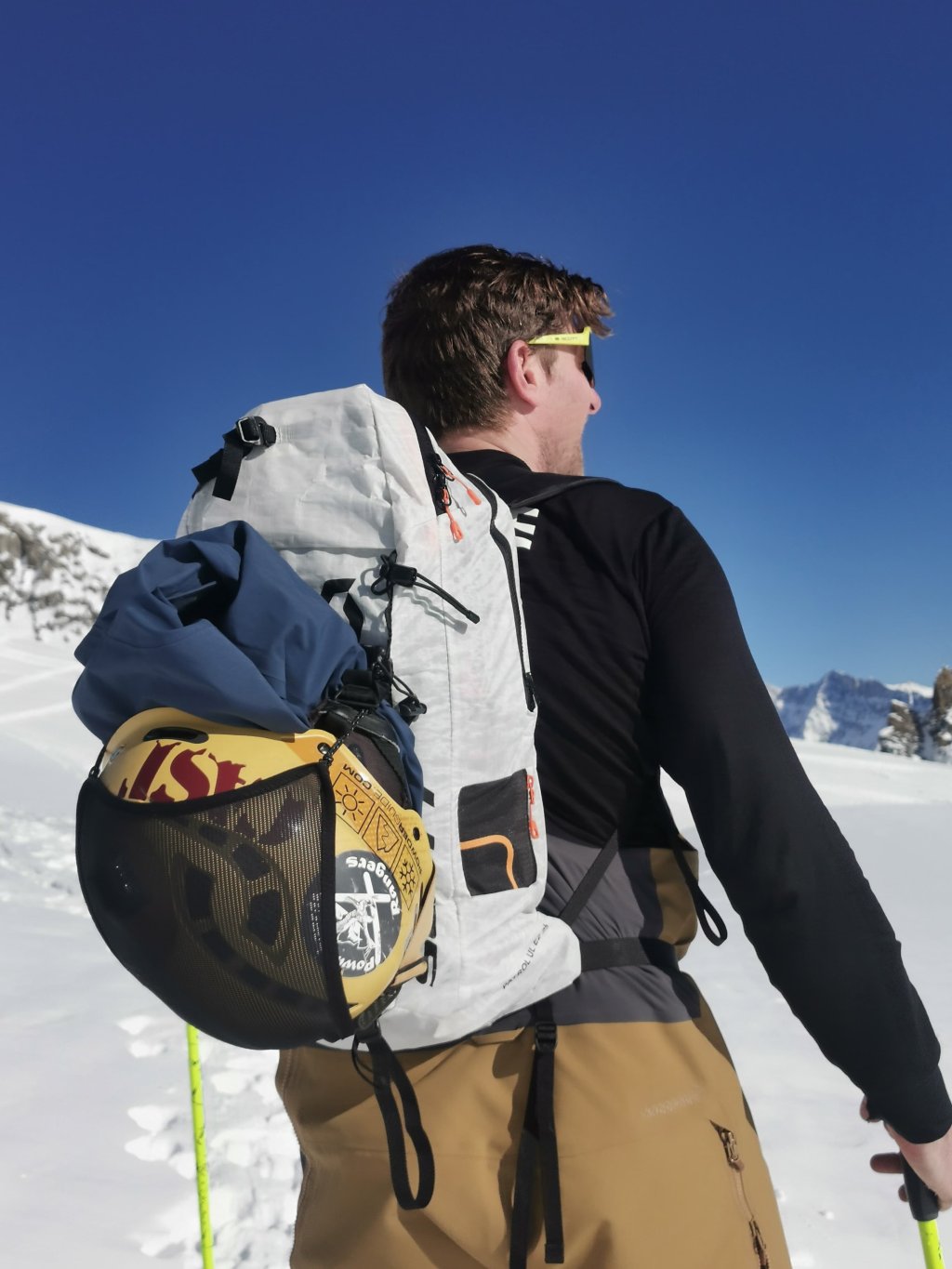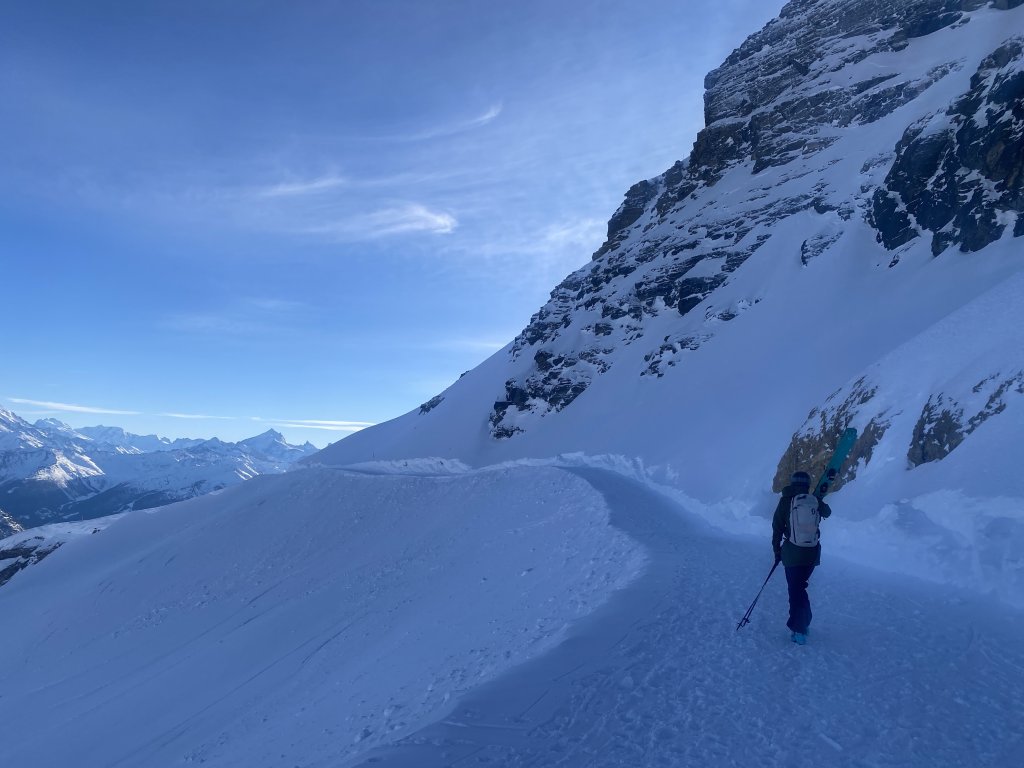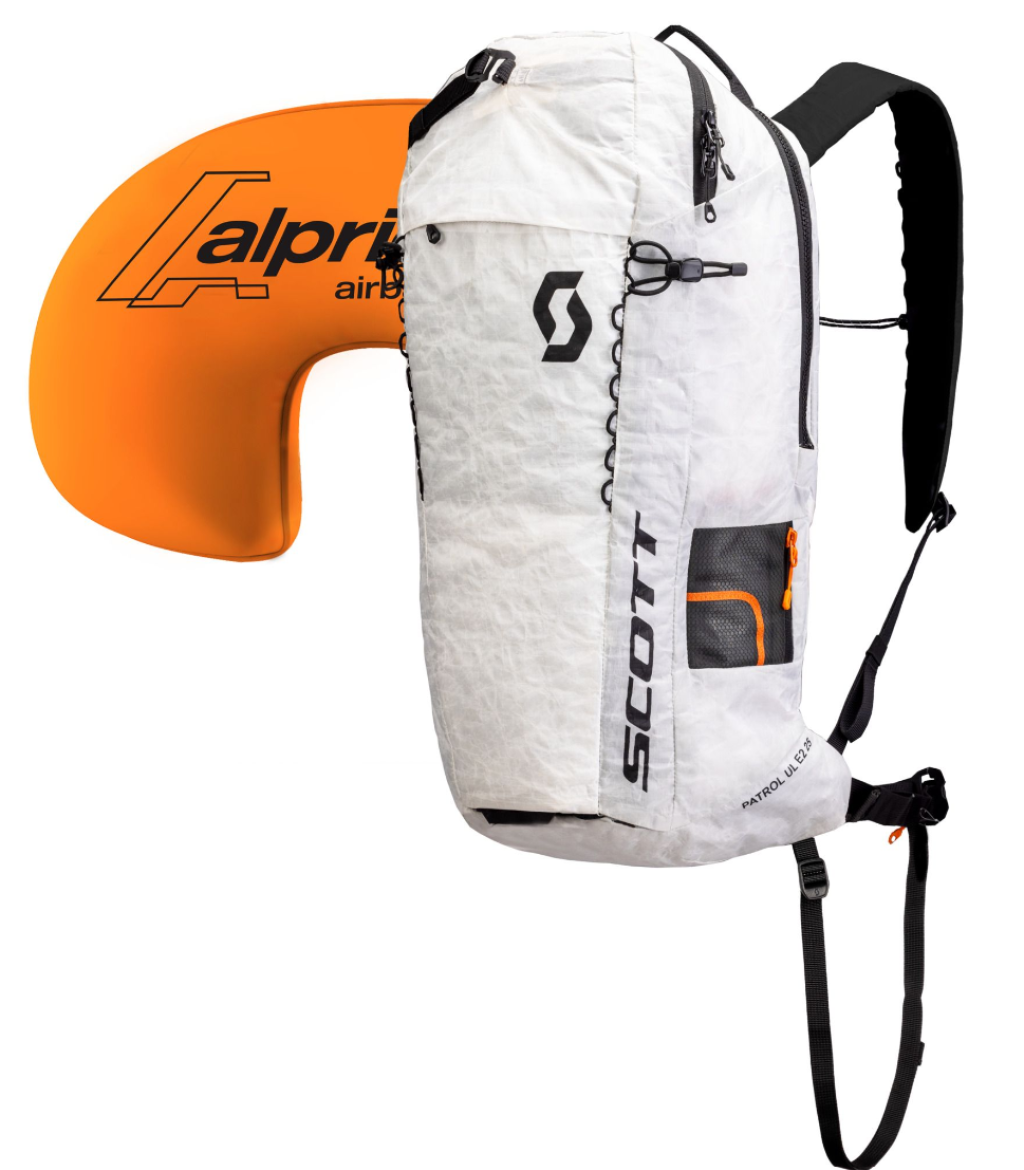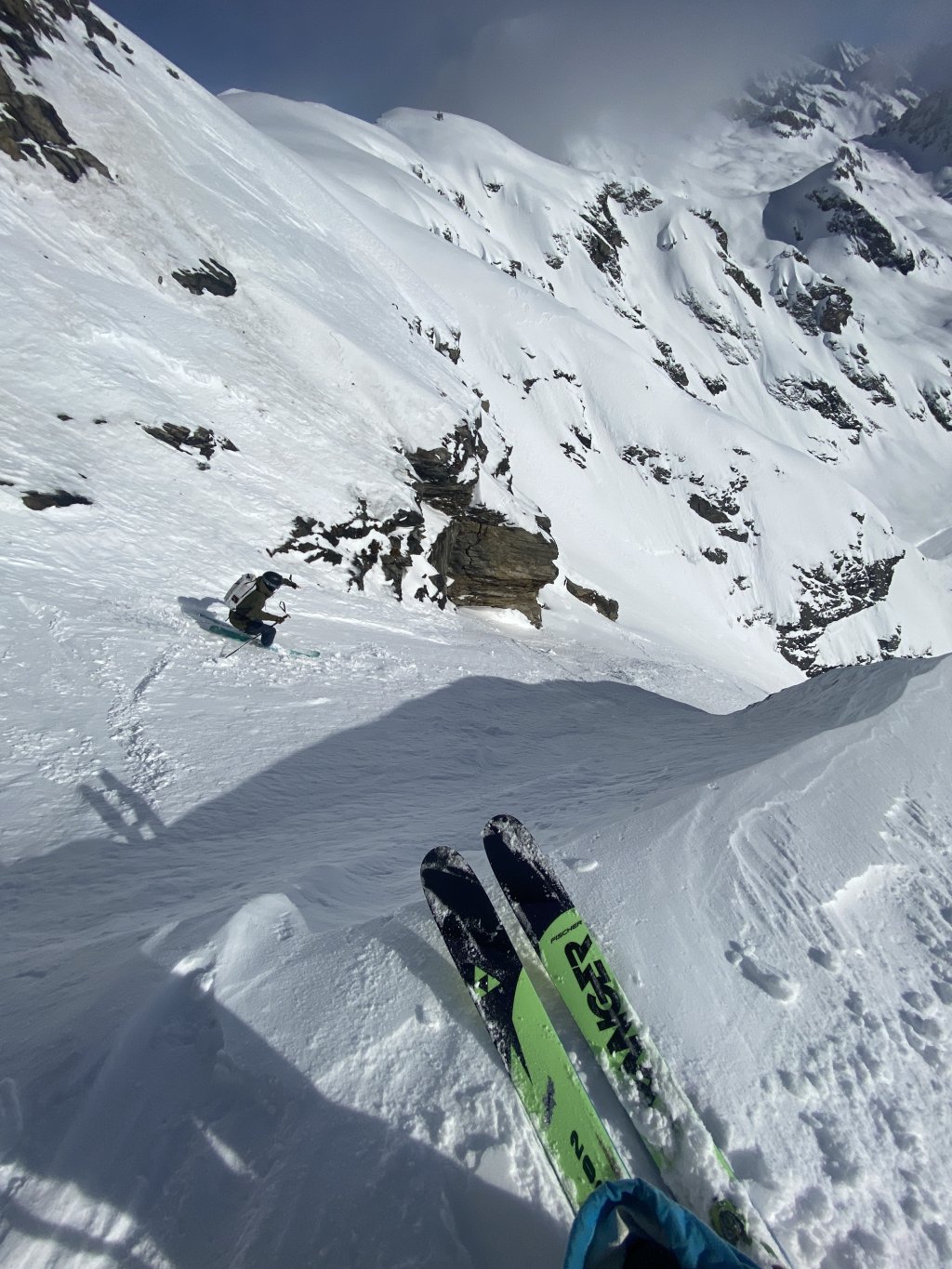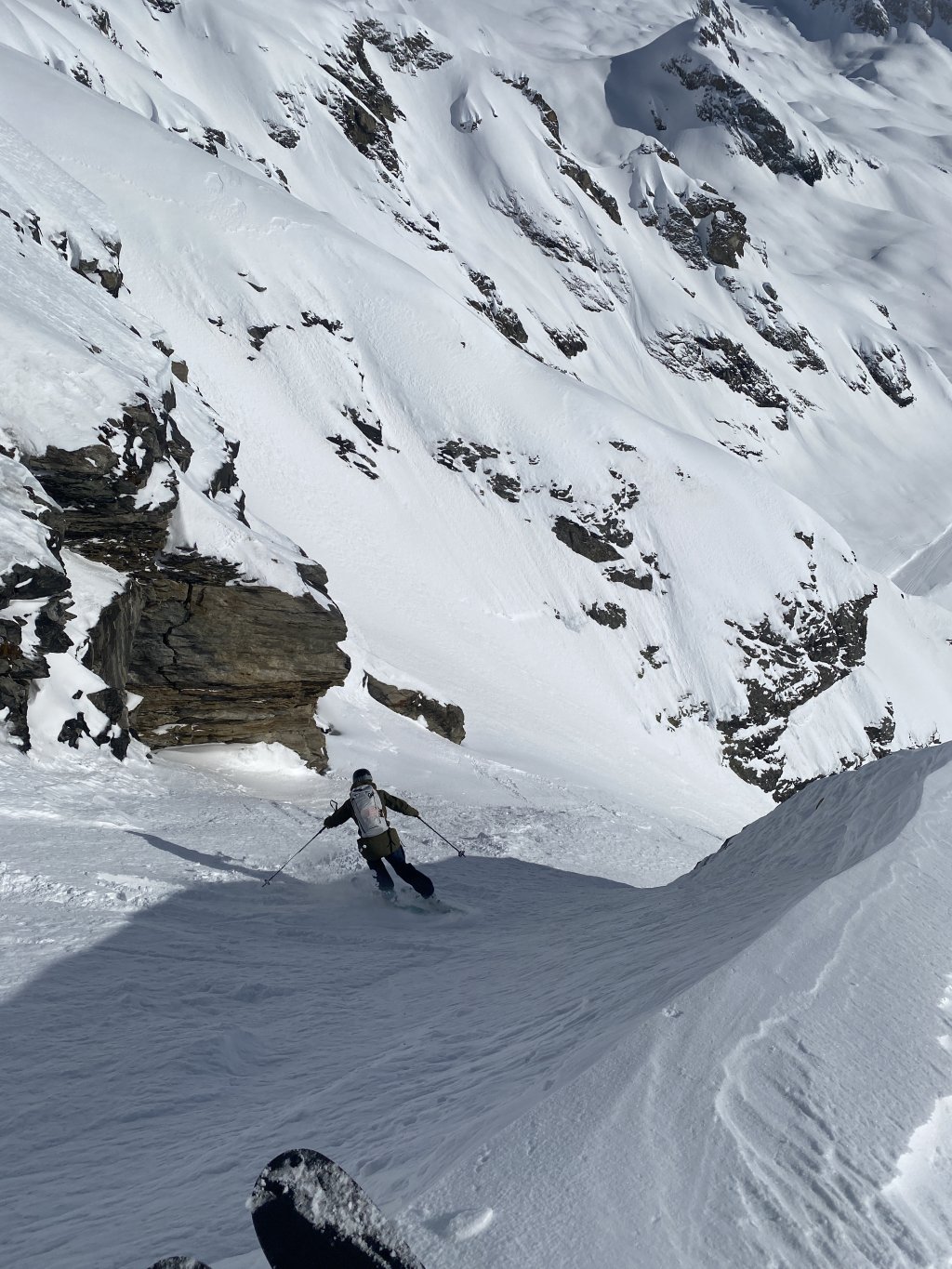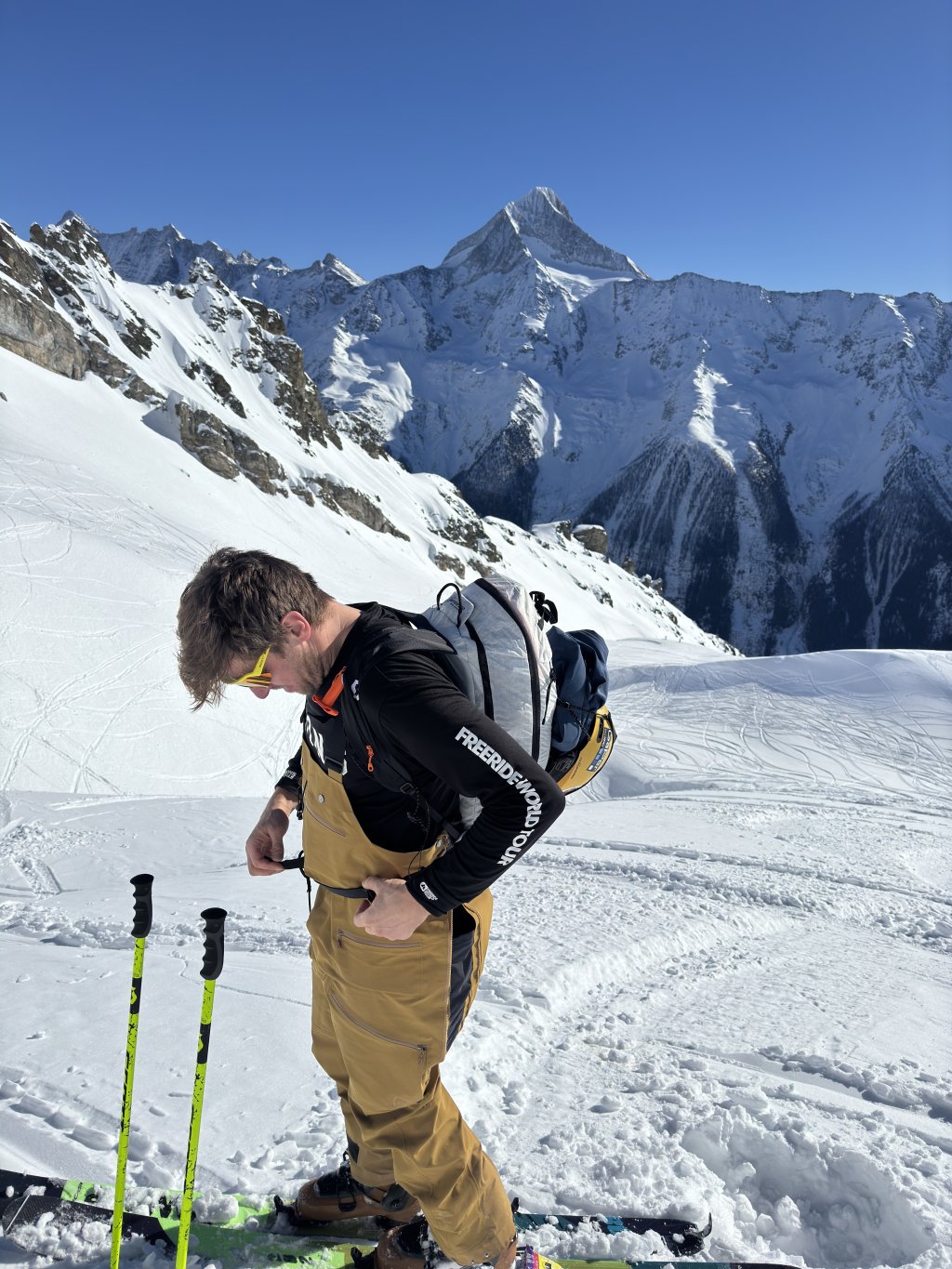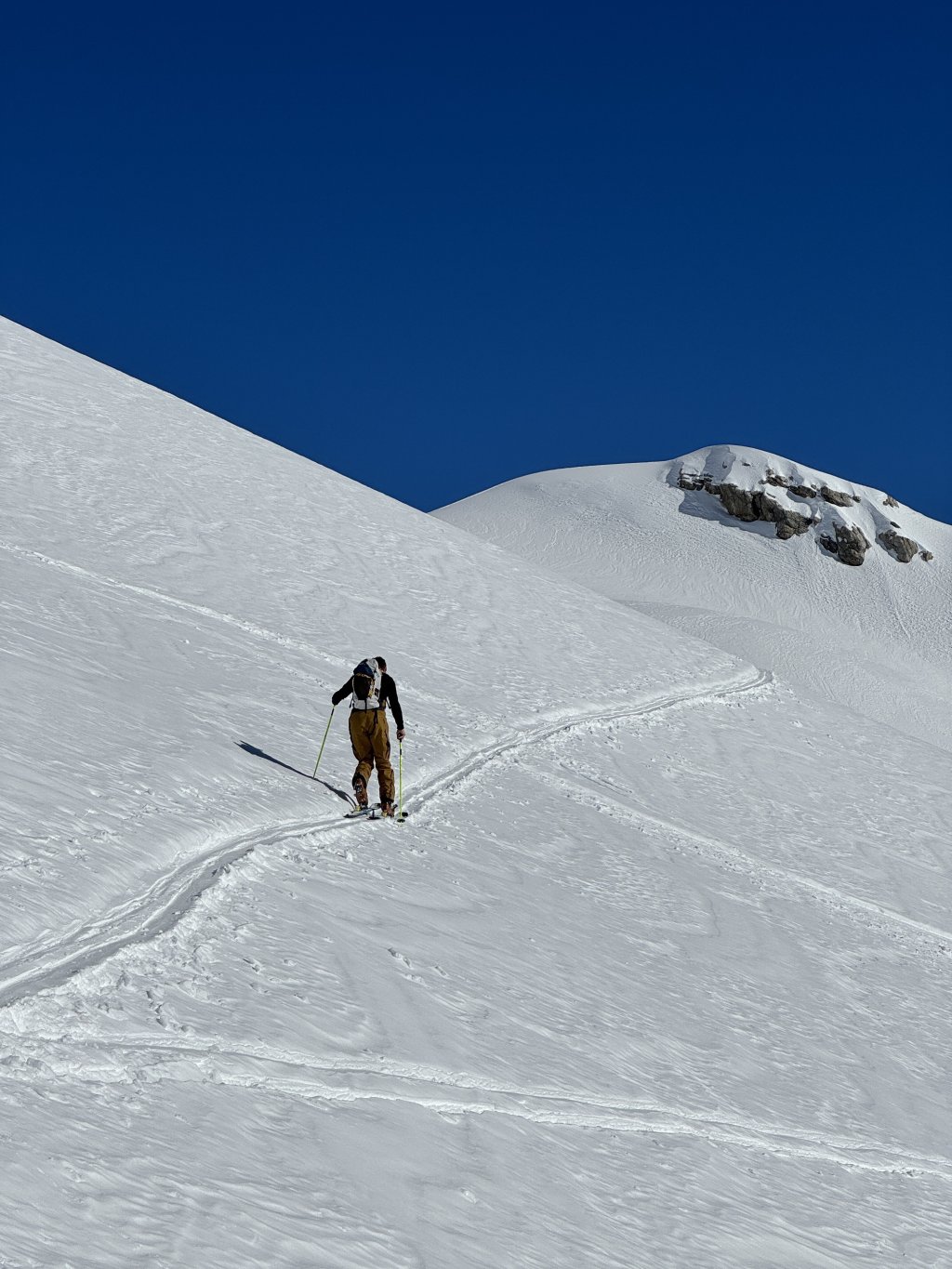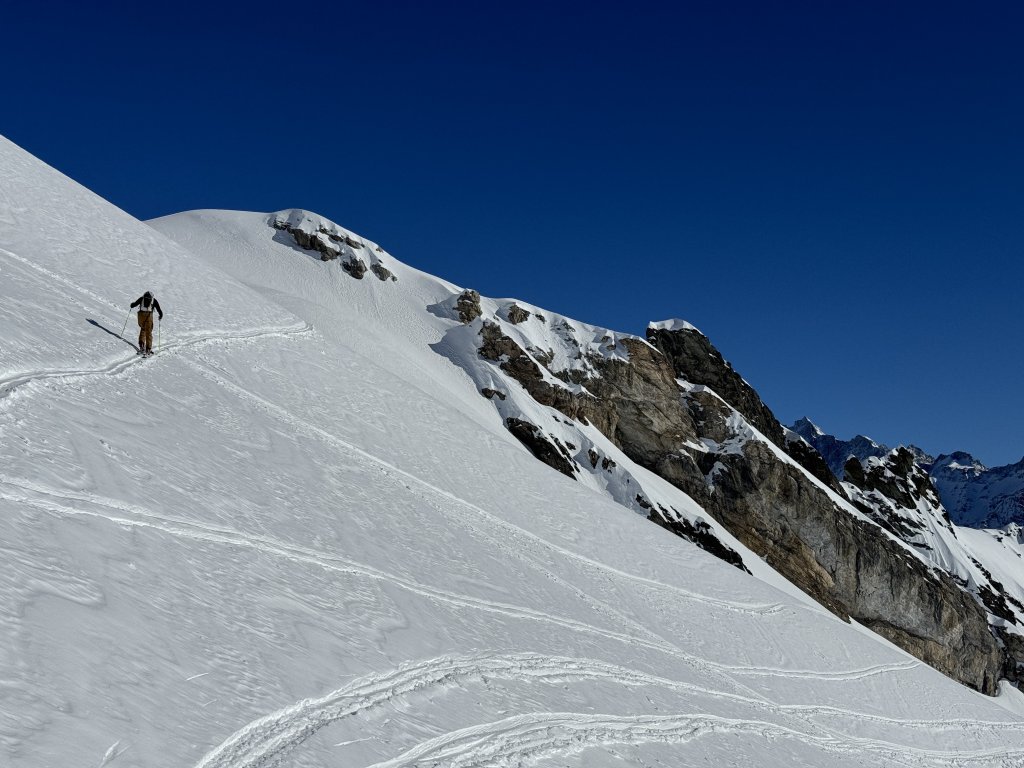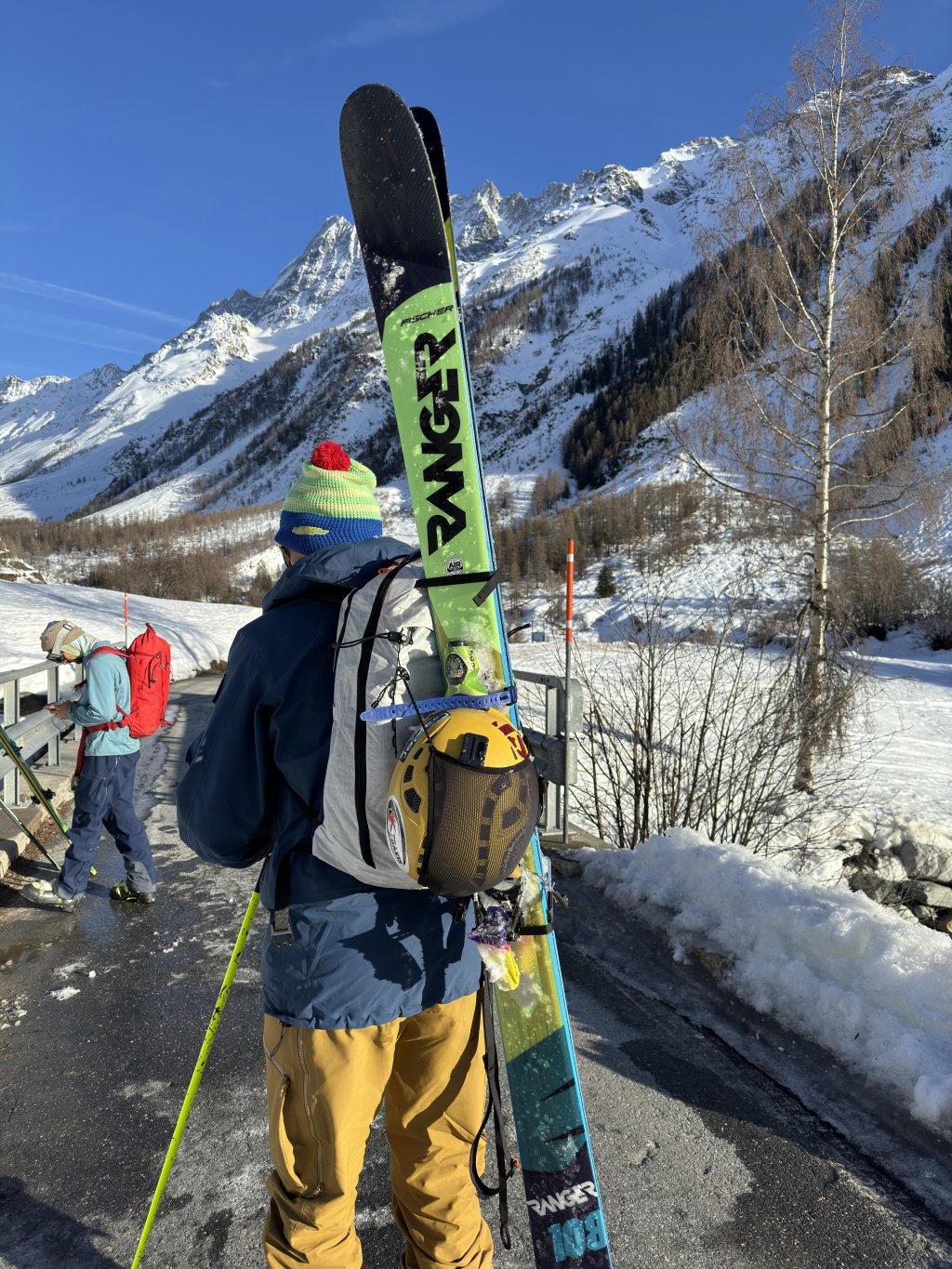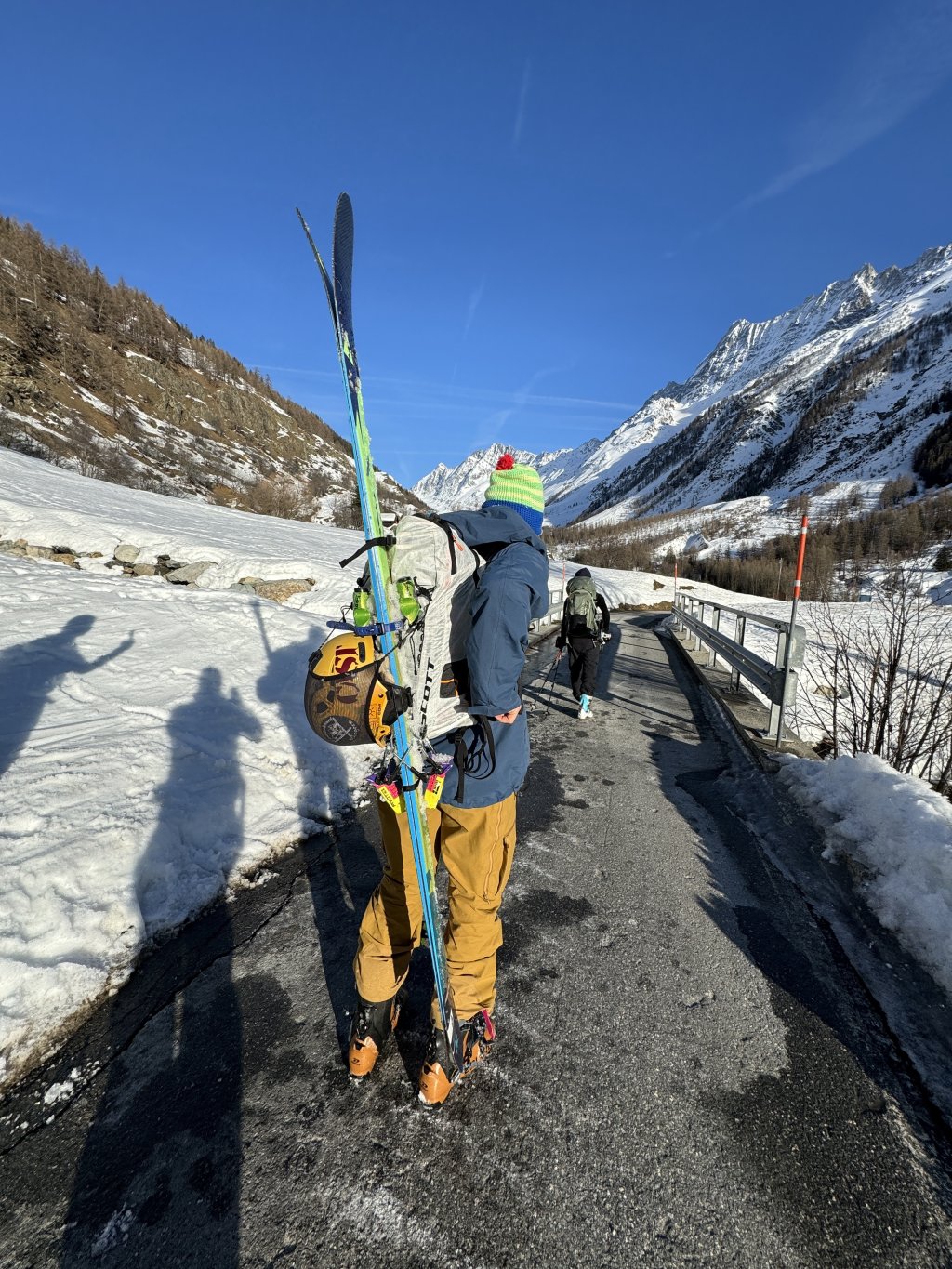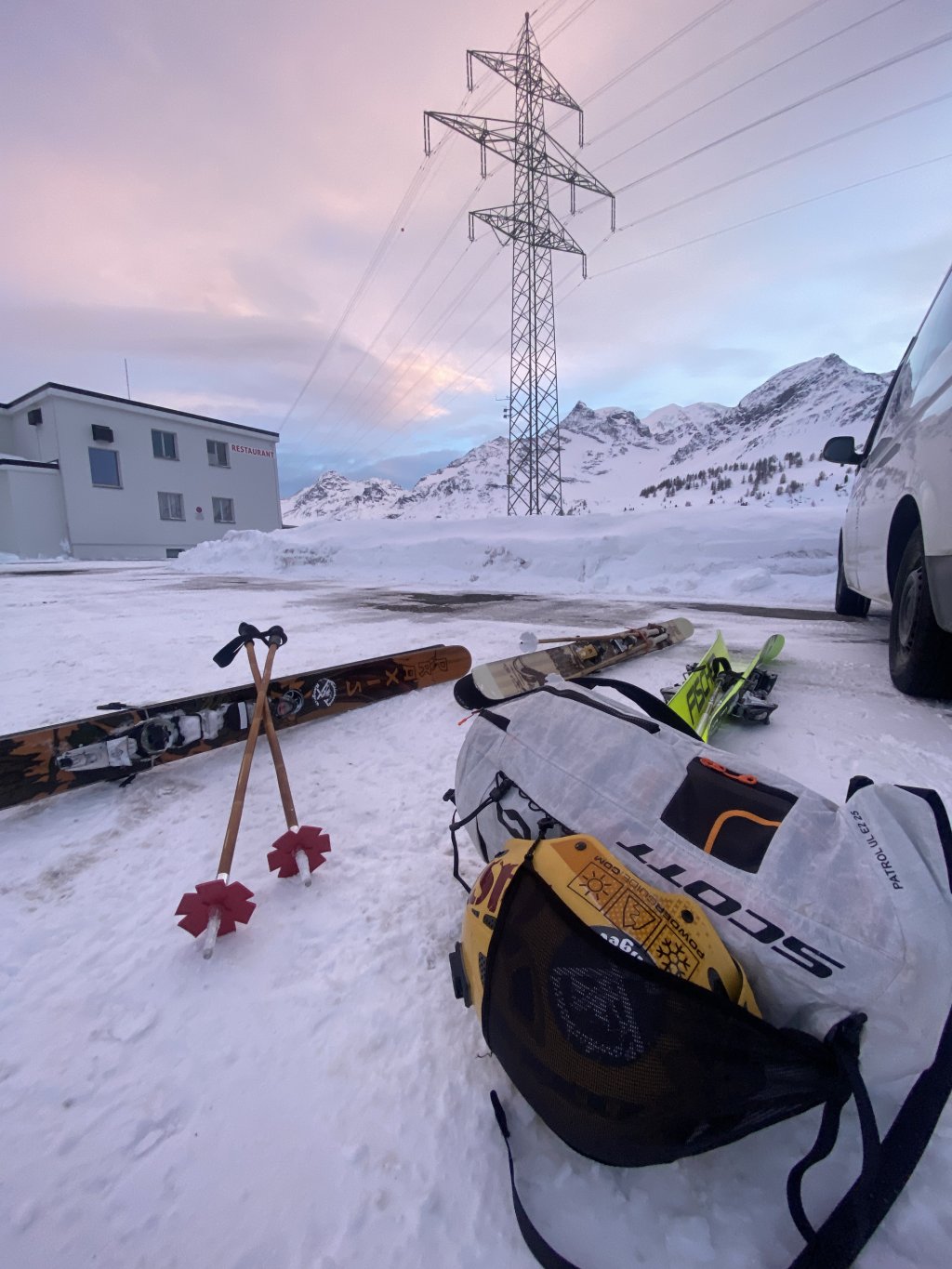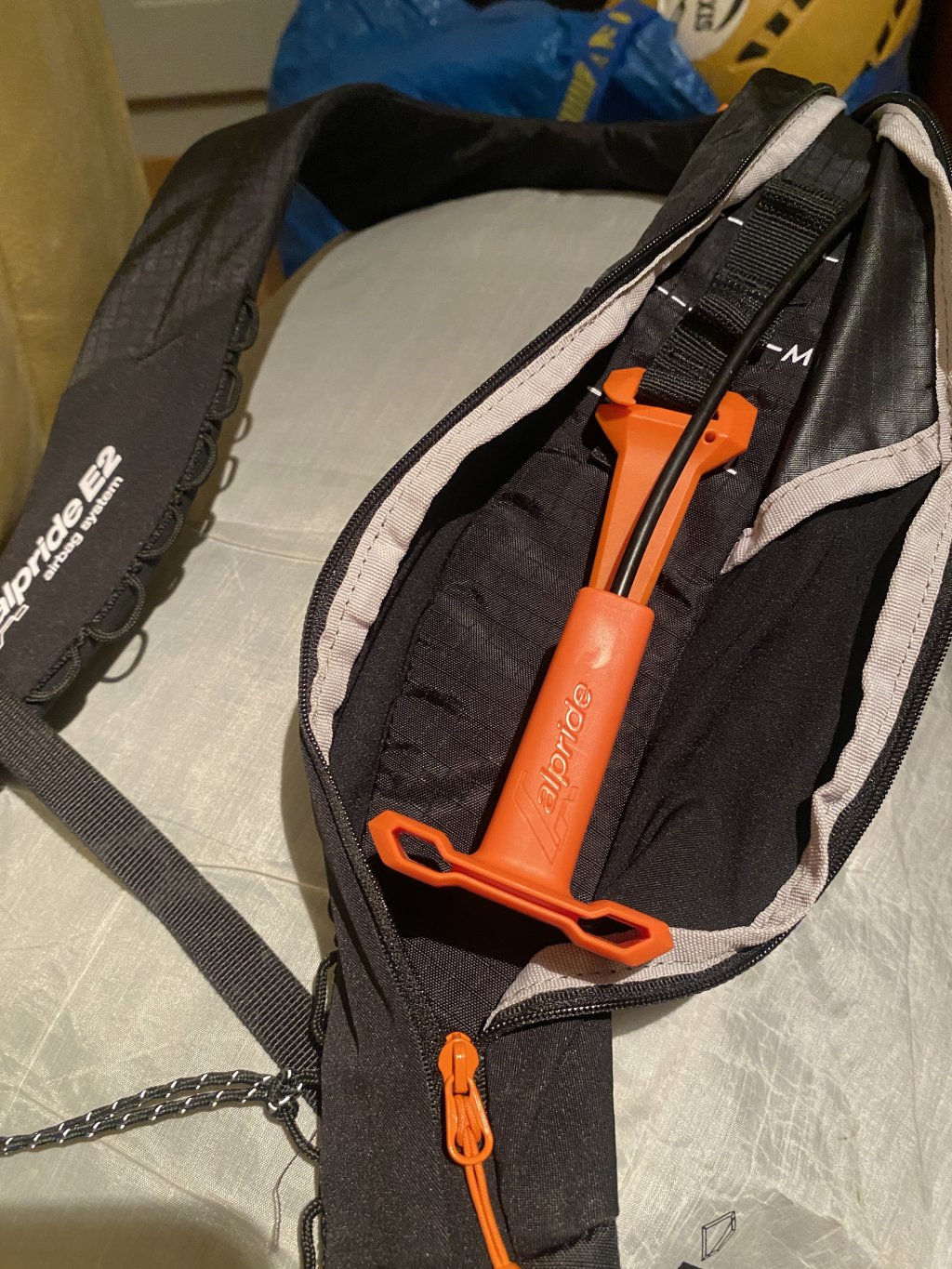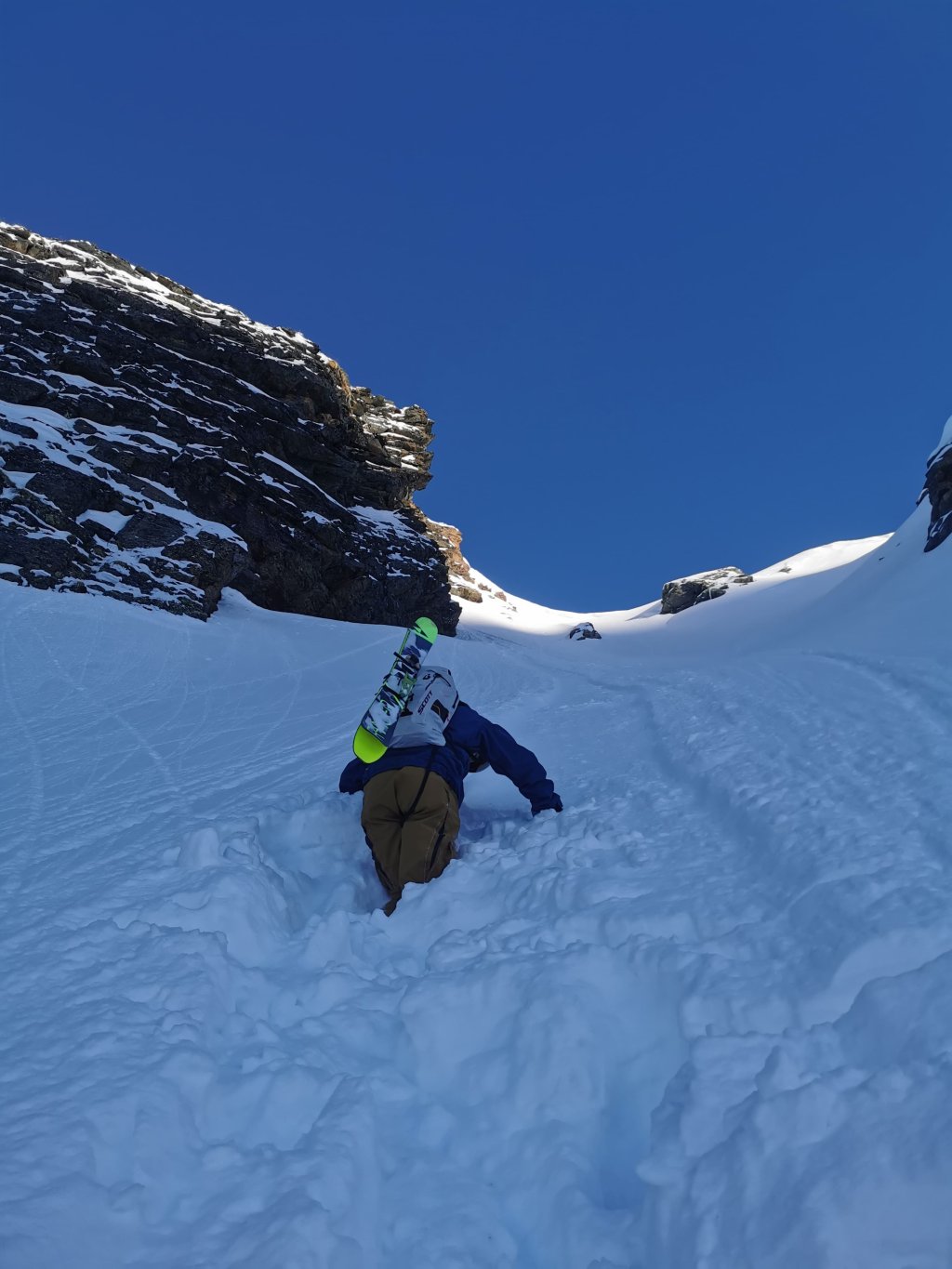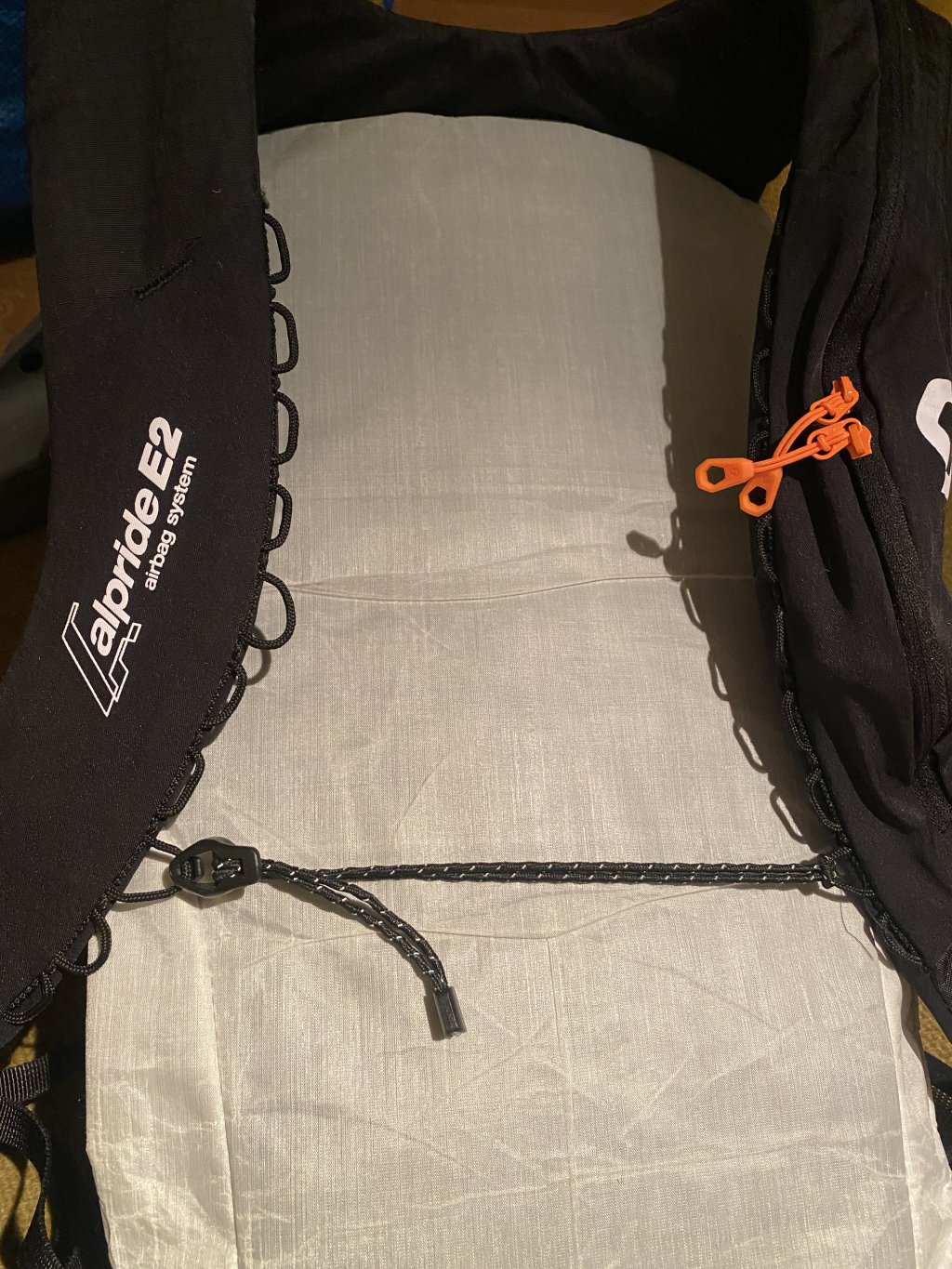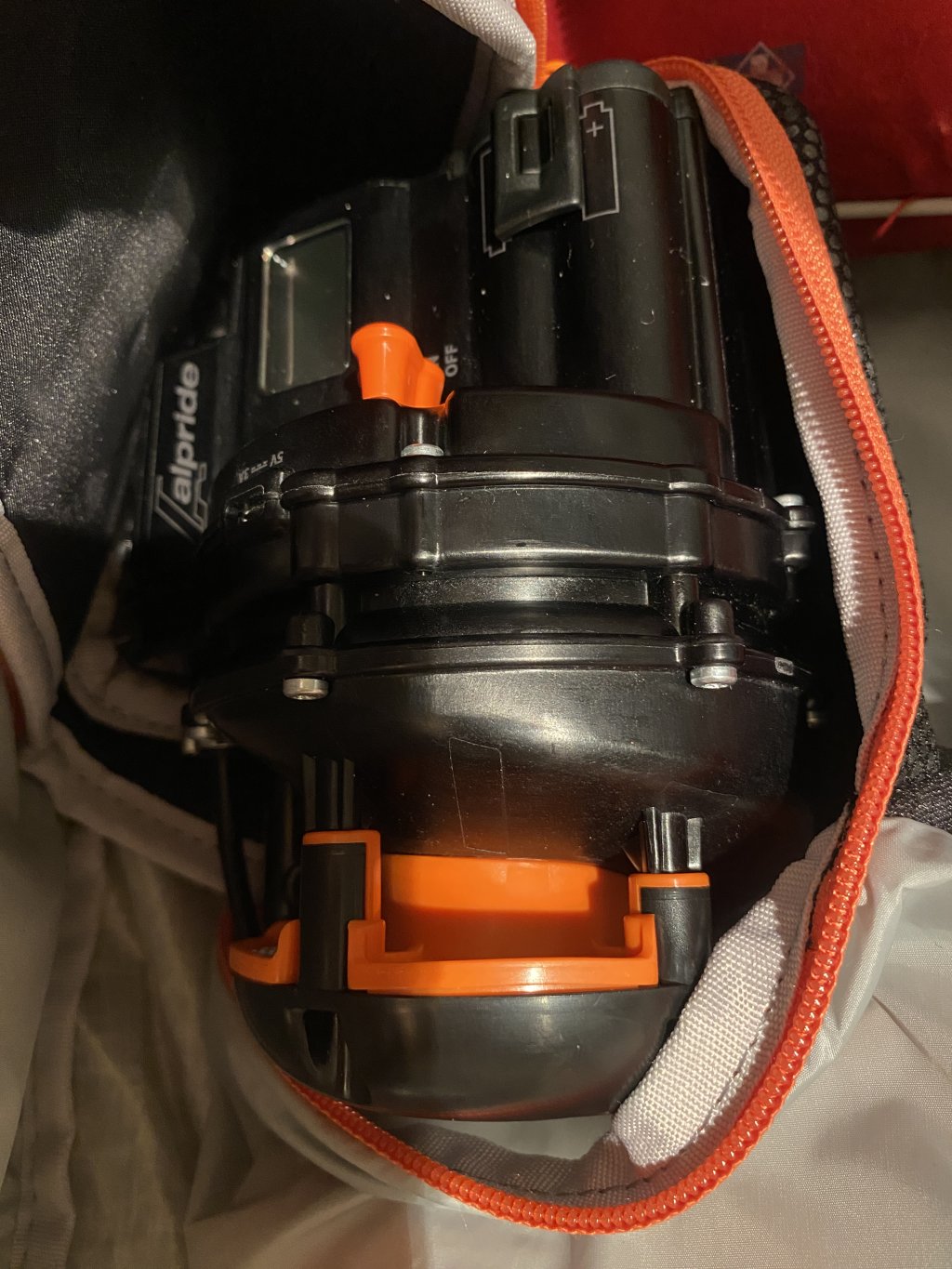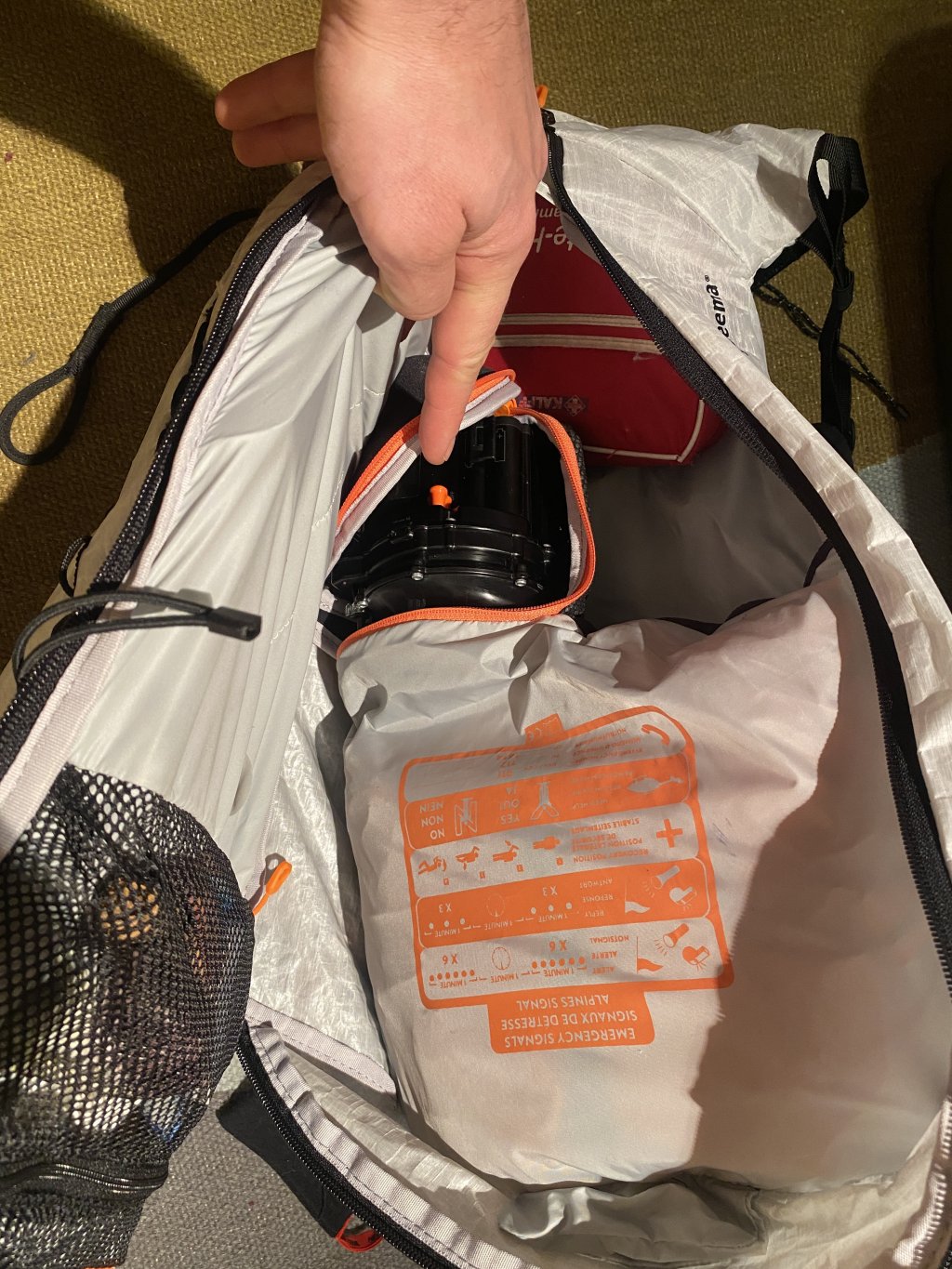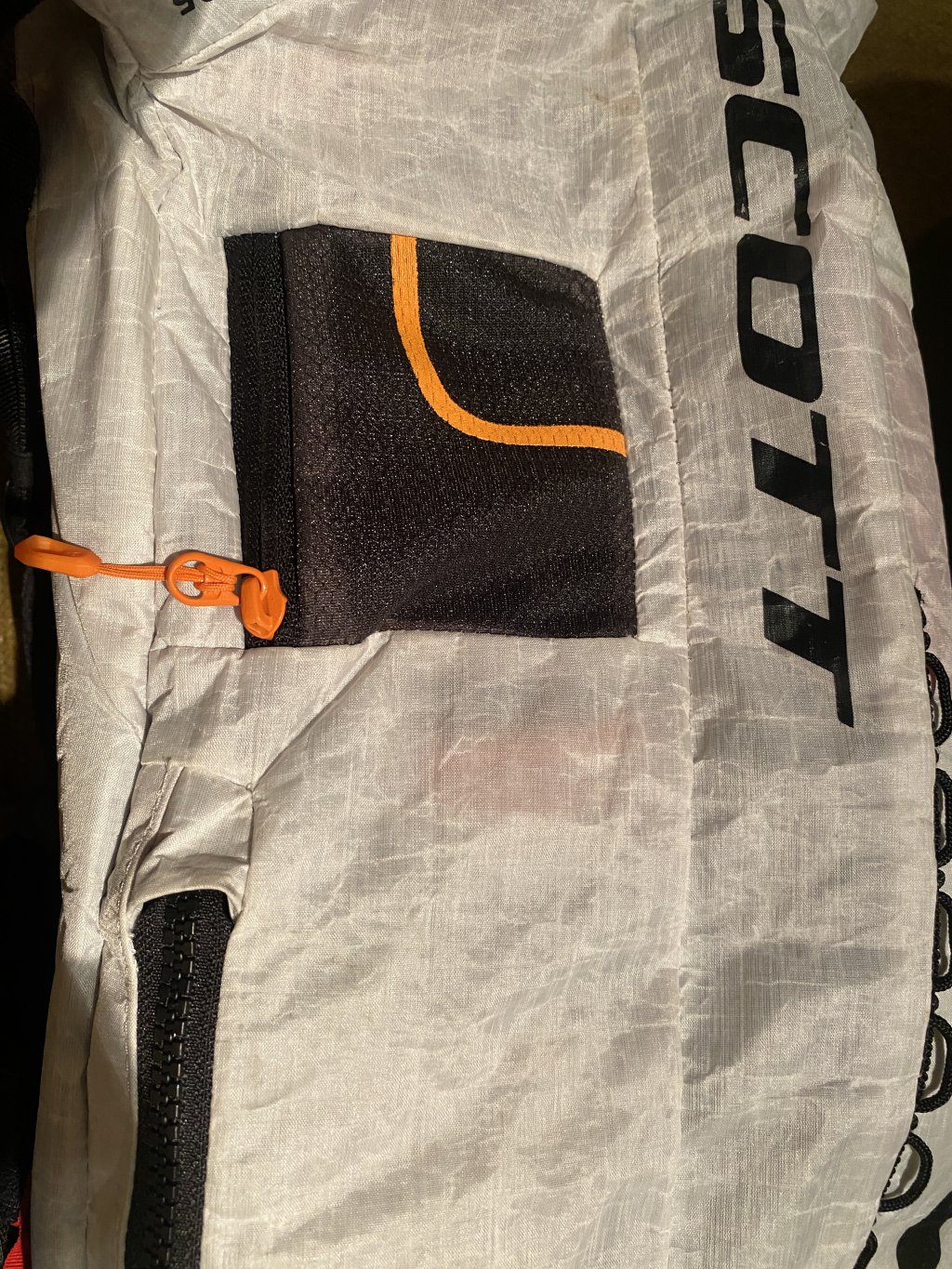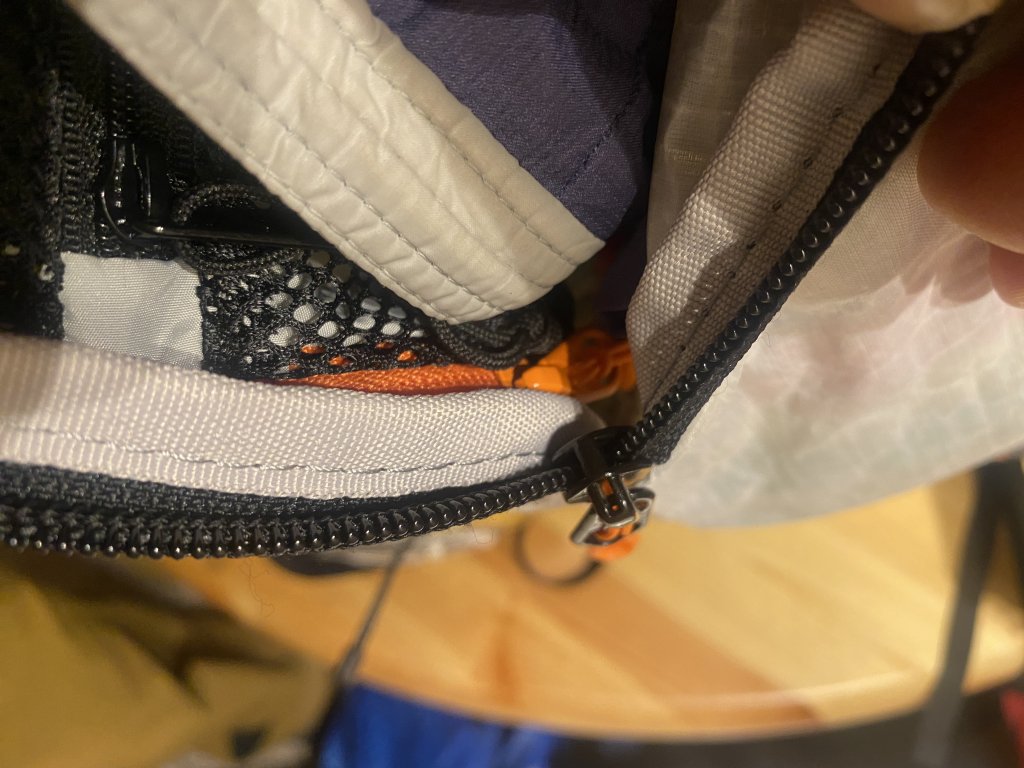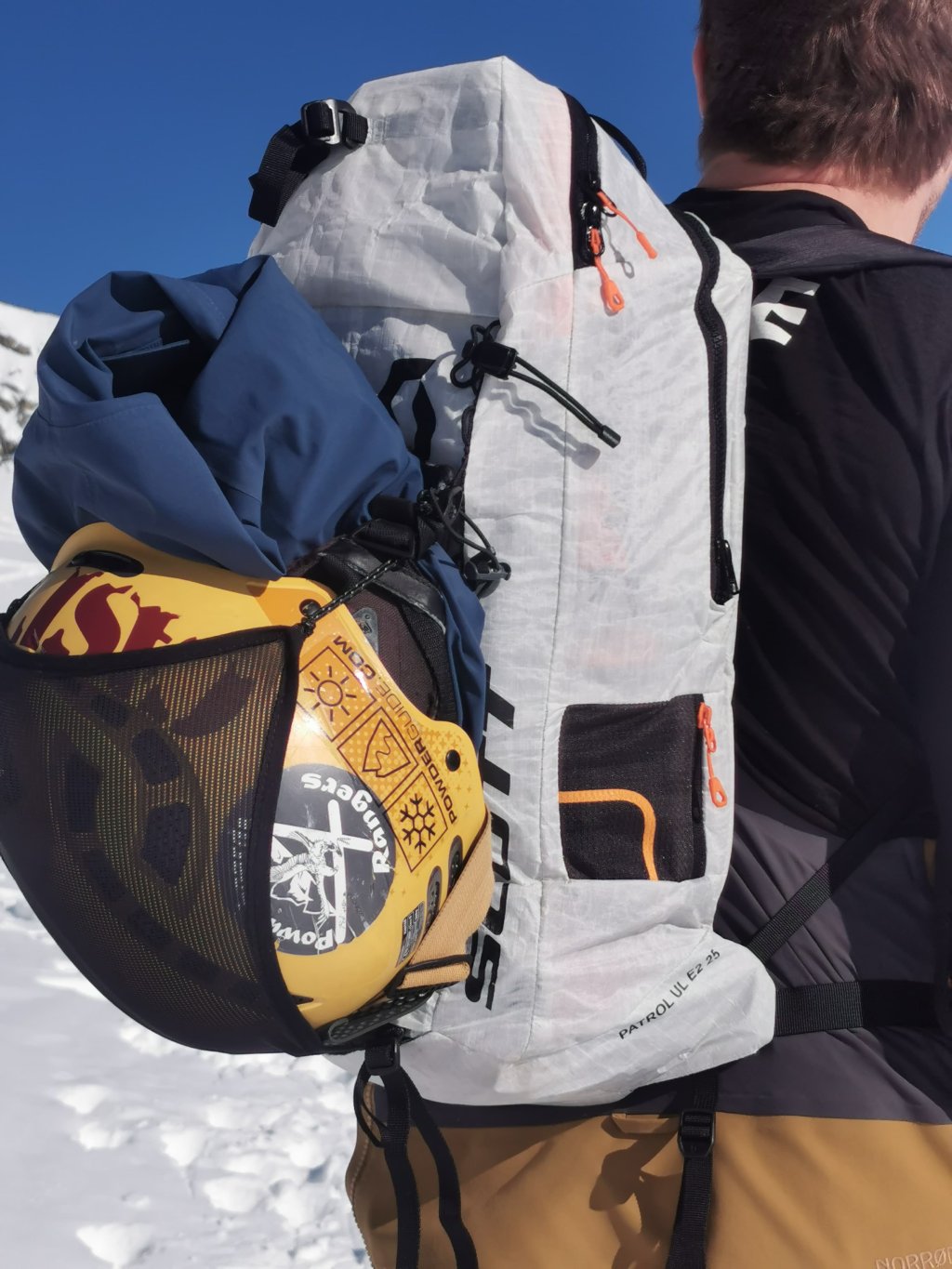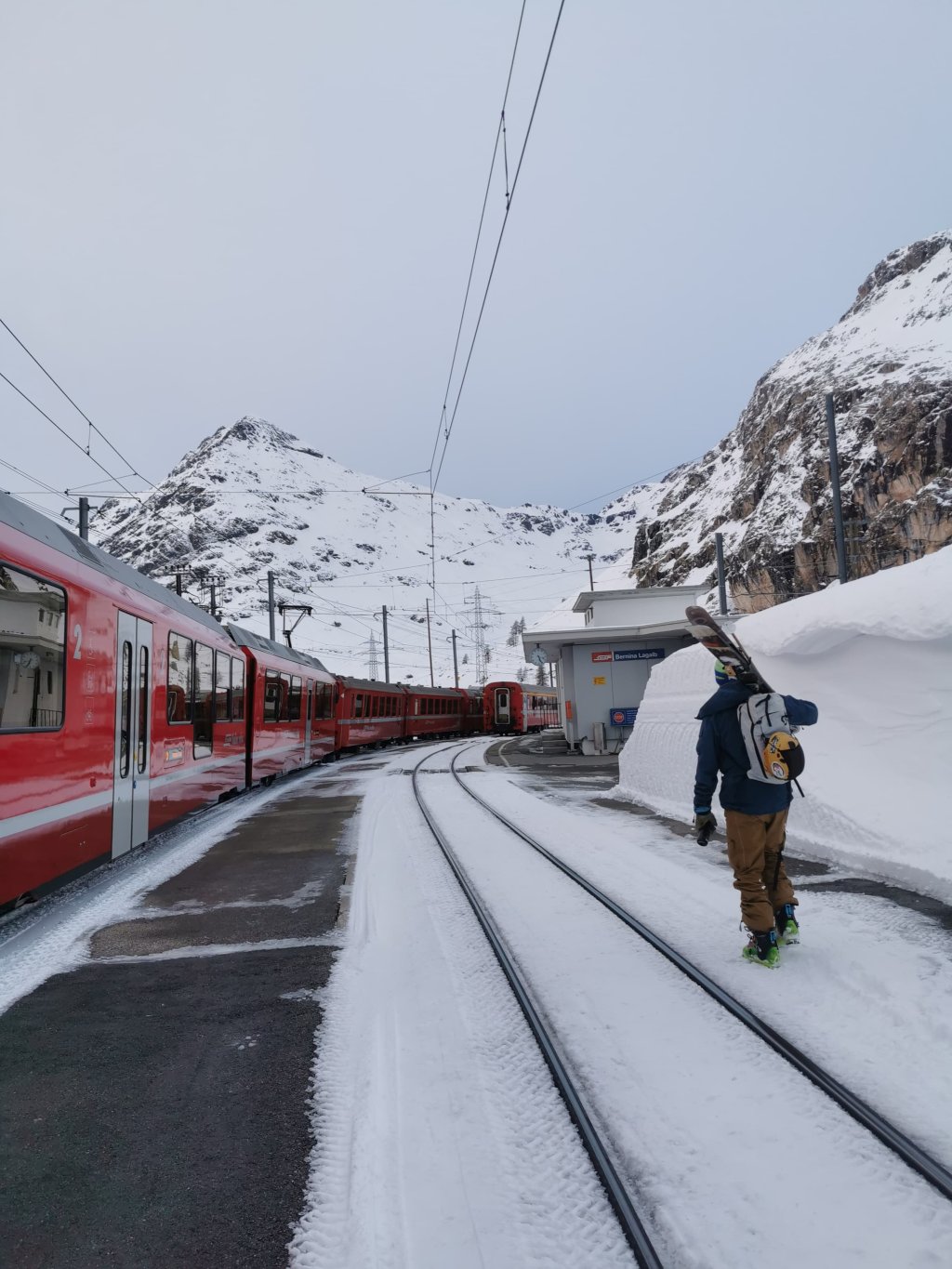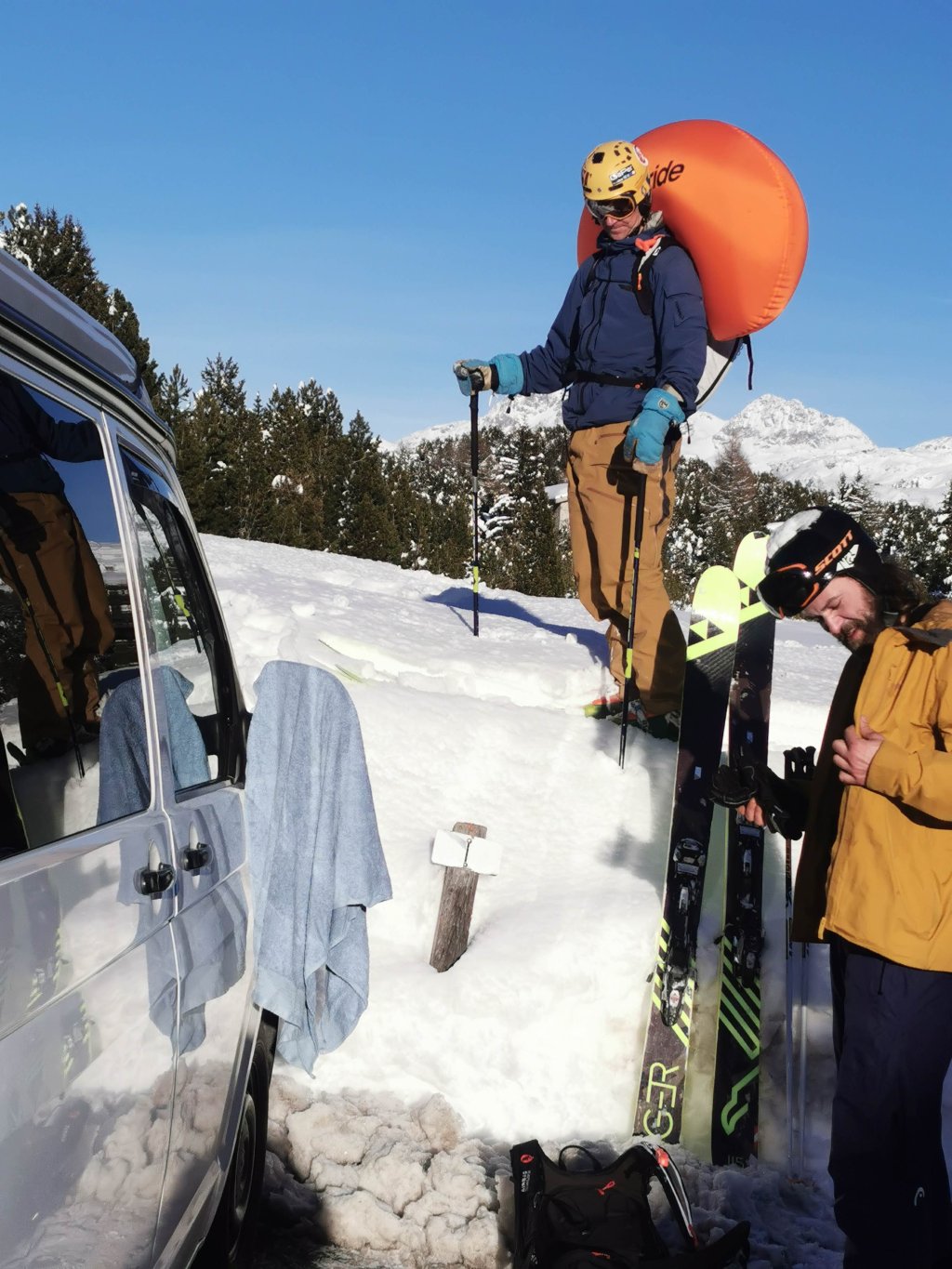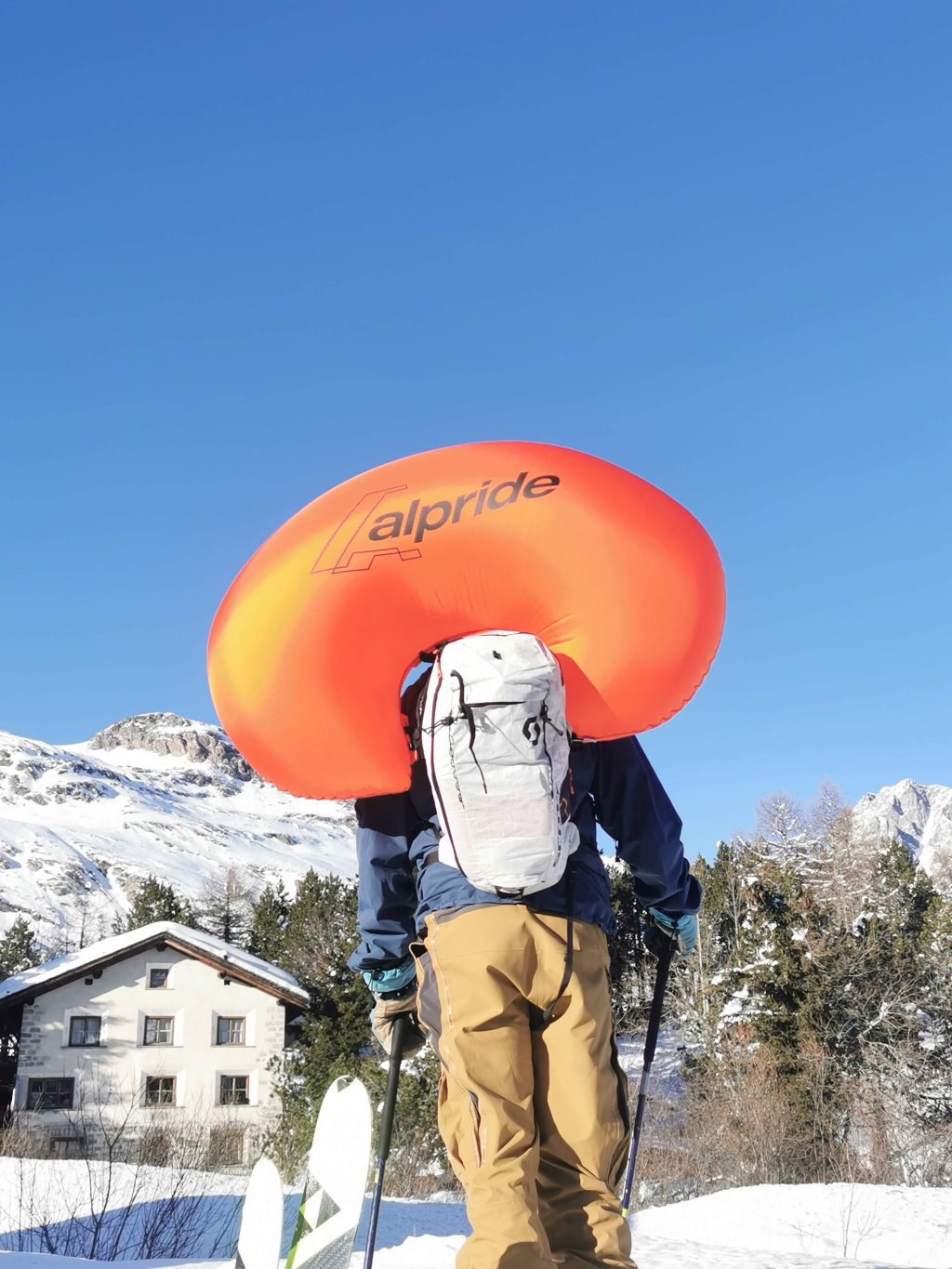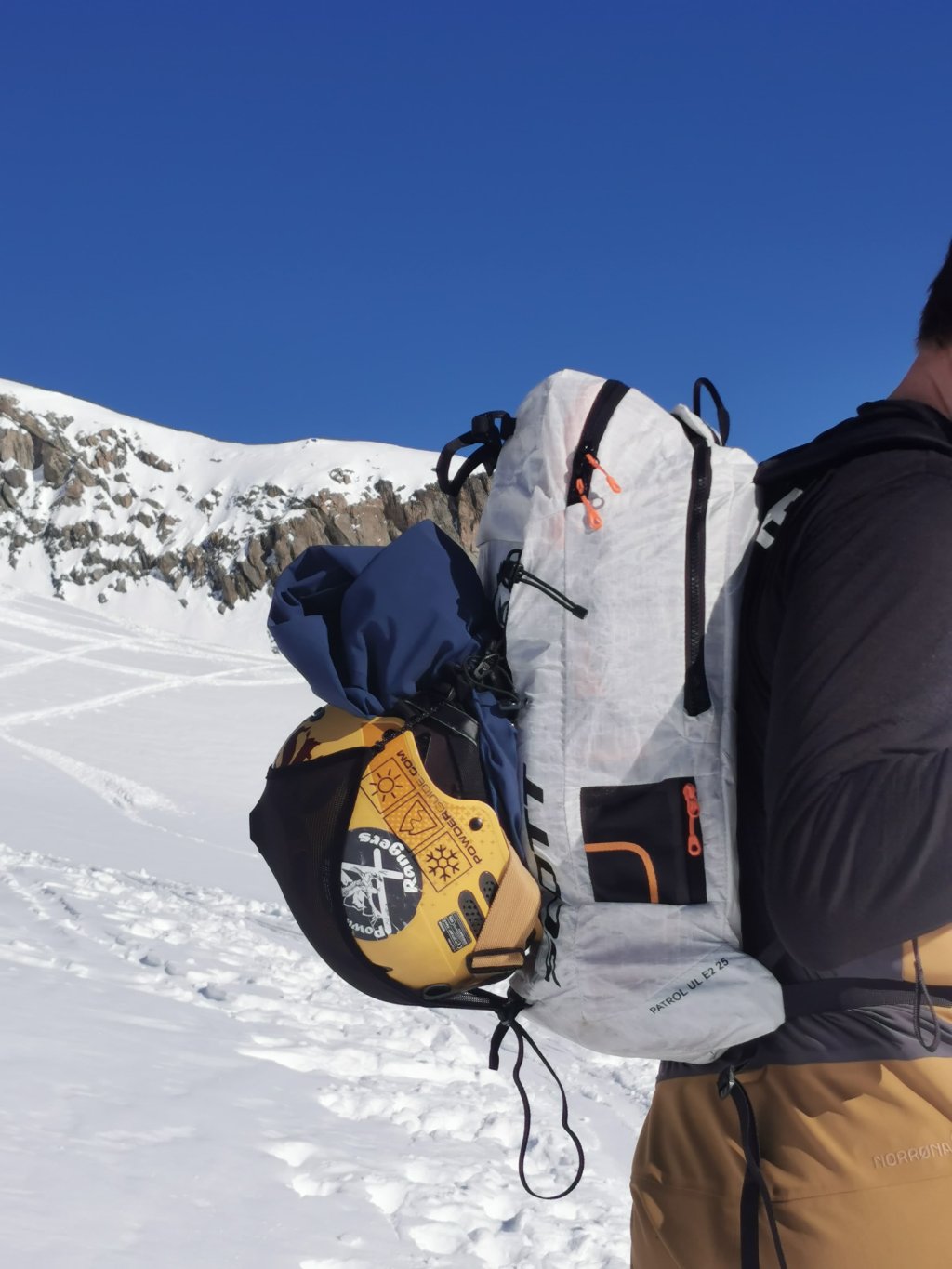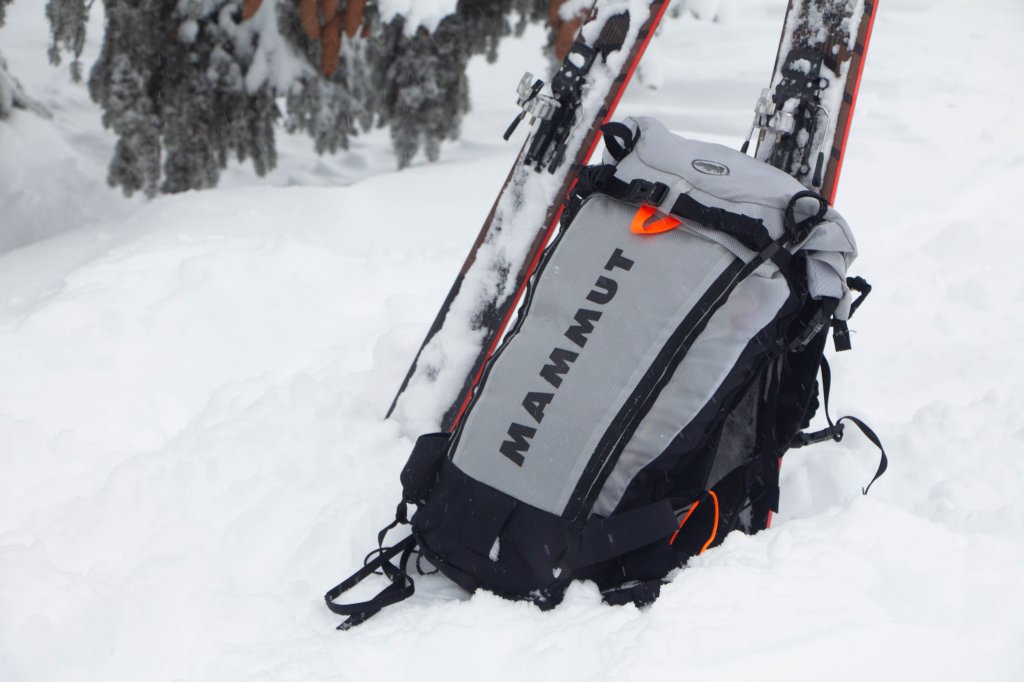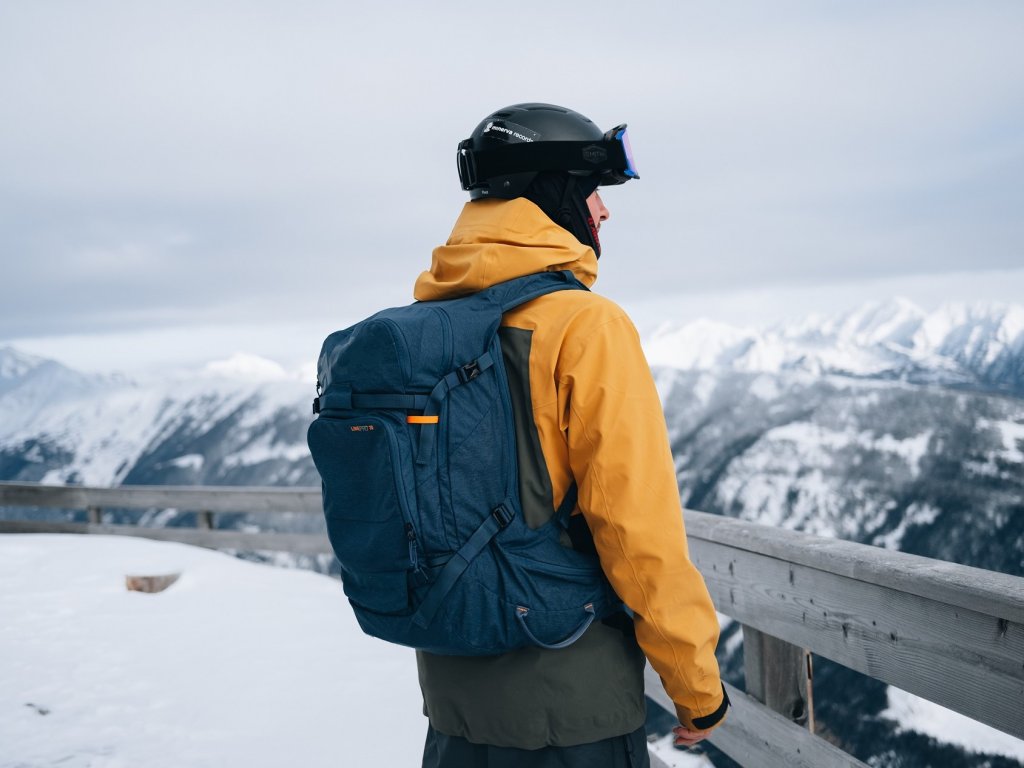The backpack carrying system was a positive surprise for the tester. It is amazingly comfortable, even with a long back and a heavy load, although the back length of 43 cm is unadjustable and only moderately long. The backpack has narrow shoulder straps and tensioning straps that work effectively. The weight-saving sternum strap looks very minimalist, as it is simply an attached cord. Despite its somewhat awkward length adjustment, it works well and you get used to using it.
The hip belt is tricky to fasten and is difficult to use when wearing gloves. On the plus side, once fastened it stays in place and does not come loose, which helps to support the carrying system considerably.
The narrow hip belt and the leg loop typical of airbags are positioned close together and tend to twist if they dangle freely. In such cases, they must first be untangled. There is a risk of confusing them due to their similar narrow construction. The buckle of the hip belt is located very far out to the side. When the backpack is full, it can be difficult to reach the buckle, as it is difficult to reach with an outstretched arm, especially as the backpack rotates when you turn your upper body.
We were impressed by the back padding, which seems to provide just the right amount of cushioning. We found it very comfortable on the descent, certainly also because the backpack is very light. During the ascent, carrying it was remarkably unobtrusive. The handling, for example when converting on the steep slope to the descent, was flawless.
Although the backpack is flat and rather small, the centre of gravity is far away from the back when it is lightly loaded with the external safety compartment, which is always full. There is no way of securing the contents closer to the carrying system or the back. However, the main compartment usually fills up quickly, so this is no longer a problem. However, chairlift rides are still better with other backpacks that can be compressed.
The backpack has an integrated helmet net that is quickly ready for use and can be fastened with two small hooks. It can be stowed away again just as quickly. Together with the helmet net, the lower ice axe holder and the lower loop of the ski carrying system can be stowed away, keeping everything neat and organised.
The upper ice axe holder is minimalist, consisting only of a simple elasticated strap, which nevertheless fulfils its purpose.
The ski holder is more suitable for shorter carrying distances. When carried upright on flat terrain, the heels quickly come into contact with the ends of the skis. This may be less of a problem with short touring skis. Unfortunately, it is not possible to carry the skis as an H- or A-frame, partly due to the lack of compression straps for the main compartment.
The main compartment can only be used with good "Tetris" skills, as you have to pack skilfully around the Alpride system and behind the shovel and handle. A large thermos flask or a lens can become a challenge. In the end, however, everything fitted in for an extended day trip. Although the packing list was minimalist, the items of equipment - such as the cast freetouring system, 2 m of skins for 118 skis and a 1.5-litre bottle - were rather bulky overall.
The goggle or small parts compartment consists only of a net and is located at the top of the safety compartment. The risk of breaking a pair of glasses or goggles with a shovel handle has fortunately remained theoretical to date. There is an additional small compartment located in the centre on the outside and below the inner compartment. However, only something flat really fits in here, as it rests on the shovel blade (for example a bar of chocolate, which everyone can actually see).
The spartan equipment in the main compartment and the Alpride system make it difficult to integrate a hydration system. A walkie-talkie with a hands-free system through the shoulder strap would probably fit.
The airbag system
First of all, there is one noticeable shortcoming: the EL2 system can more or less only be switched on when the main compartment is empty. To activate it, you have to expose the blower-battery-capacitor system deep in the backpack with a somewhat fiddly zip. The airbag can be activated by means of a rotary switch, which must be pulled at the same time as the fuse. The system switches on audibly with a buzzing noise that ends with a click. On the outside, the starting process of the system is signalled by the three LEDs lighting up, which should be visible through the black mesh cover. If there is any uncertainty, for example because the sound has been drowned out by snow plough noise and the LEDs have not been noticed due to dazzling morning sunlight, the charge control LED indicates the battery status in the corresponding colour by flashing pulses at longer intervals: Green means "OK", yellow stands for "Time to charge" and red signals "Last chance". More on this in a moment.
The release handle is secured simply by means of a thin, very stretchy fabric that goes over the handle. The handle is exposed by opening a zip on the shoulder strap. With a little patience, this can also be done with gloves. This is a right-handed backpack. The height of the handle can be adjusted in three stages, but people with larger shoulders almost have to reach for their ears. The release probably only works when the hip buckle is closed, as otherwise the backpack turns with the movement towards the handle and there is not enough resistance to pull the orange-coloured lever.
Deployment is audible after one second of reaction. The blower breathes into the airbag from the outside through the small mesh opening, the Velcro fastener above the zip opens with a "pop" and the orange airbag quickly fills completely.
The pressure decreases over time. We didn't notice the re-pumping, which is supposed to take place every 2 minutes, but the pressure didn't really decrease either.
It takes a practised hand to deflate the airbag. The deflation switch under a slider must first be uncovered and then pressed, while the airbag is compressed and folded with the other hand. With a little practice, however, this works quite well. In any case, folding the airbag is now intuitive and quick. The zip that covers the airbag is located under a Velcro cover. As with all comparable airbags, the non-hooking teeth at the top centre are "forcibly" separated when the airbag is deployed. To restore the initial state, the zip fastener must first be fully opened. Then pull back the shuttle, thread it in again and then close the zip completely. Finally, press the Velcro patch closed. One small special feature that catches our eye is the pragmatic way in which Scott has designed the zip fastening. The zip ends are initially on the outside and are simply tucked under the Dyneema fabric of the airbag compartment. With a little courage, this can easily be done with one finger. Ultimately a convincing solution, although we were sceptical at first.
Due to the design, the airbag compartment is located between the carrying system and the main compartment, and depending on how wilfully the latter is closed, the airbag cover zip may pop open when the backpack is put on. For example, a helmet in the helmet net that was pulled to the side in a crowd was enough to expose the airbag.
The system is charged electrically, very practically via a USB-C socket. This can be accessed via one of the two zip fasteners leading to the Alpride unit. The scope of delivery includes a high-quality USB-C to USB adapter cable, which is particularly practical due to its angled shape. Charging on the 12 V camper on-board power supply worked. I did not pay attention to the transmitted current of the 12 V plug, but charging from yellow to green was possible in 6 hours.
But the power supply unit from the laptop does the job too. And how! After charging overnight, starting with a green flashing light, the LED light still showed yellow after five days of daily use and even after forgetting to switch it off at night. The airbag was then switched on and almost forgotten for a fortnight in a cold, quiet place. When it was finally switched off and on again, it flashed a warning red light. Nevertheless, the capacitors were audibly charged and the airbag was successfully inflated again two days later during a test deployment. A second attempt with the empty battery then only allowed half an inflation before the voltage for the blower collapsed. We were impressed by the battery life and reliability of the deployment system.
